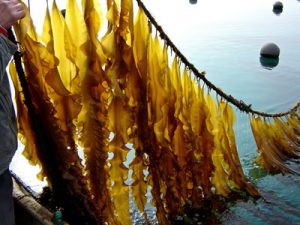
As climate change continues to impact our environments and increase the amount of dangerous weather that we experience, farmers will need to come up with creative solutions. While the impact of climate change is clearly visible through droughts such as the one currently impacting the Colorado River and recent hurricanes, it may be less evident that it also directly impacts the oceans. It does this through a process known as ocean acidification. Ocean Acidification is defined by the National Oceanic and Atmospheric Administration (NOAA) as a significant increase in the amount of CO2 entering the ocean. The organization’s entry on ocean acidification adds that, “the ocean absorbs about 30 percent of the CO2 that is released in the atmosphere, and as levels of atmospheric CO2 increase, so do the levels in the ocean.” Research findings from UMaine’s Darling Marine Center state that ocean acidification”…is primarily caused by the uptake of carbon dioxide, which dissolves in seawater and increases the acidity, making it harder for oysters to create their calcium carbonate shells.”
There are researchers and farmers working to find solutions to the problems caused by ocean acidification. One is an updated form of aquaculture, or “…the breeding, rearing, and harvesting of fish, shellfish, algae, and other organisms in all types of water environments.” The University of Maine has been working with the aquaculture industry in local waterways, but the practice is not limited to that area. Long Island Sound fisherman Bren Smith began using the 3D Farming method after seeing how trawling, or dragging a net through the water to capture fish, also destroyed undersea environments. There is now an intentional consideration of how their techniques can support and promote environmental health. 3D farming, or the “buoy method”, is an aquaculture technique that uses the whole column of surface, subsurface, to just above the sea floor, as opposed to simply placing buoys on the surface. The farming of shellfish on the sea floor is common, however, with the increase in natural disasters as a result of global warming, this method is less viable. This is because the violent weather patterns cause cages to dig up mud from the sea floor, filling cages, and smothering the animals by encasing them with the mud. The 3-D method also allows farmers to cultivate multiple crops at the same time. Farmers can grow plants such as kelp and seaweed, as well as bivalves like oysters and scallops, on the same buoyed rope. The bivalves hang in socks and cages and are thus lifted off of the seafloor by the same turbulent waves that would otherwise cover them with mud and kill them. This also allows for increased crop production, benefitting the farmers and providing new sources of food for our growing population.
In addition to being harvested for food, bivalves also benefit their environment by filtering the water. This filtering improves water quality and entices local water creatures to return to what may have previously been a polluted area. Farmers are not the only ones looking to restore environments. The Billion Oyster Project in New York City is working to restore the oyster reefs that used to be omnipresent in the city’s waters. In addition to water purification, the Billion Oyster Project explains the reefs can also decrease wave damage, flooding, and even soil erosion.
Oysters and other shellfish cleanse the water, but the issue of ocean acidification remains; is there somewhere that all of that carbon could go? Mélissa Godin’s 2020 article in Time, “The Ocean Farmers Trying to Save the World With Seaweed”,included interviews with Dr. Louis D. Druehl, a climate scientist who found a possible solution to ocean acidification in the form of kelp back in the 1970’s. Godin also cites a 2020 article from The Guardian that found that the “large brown seaweed… can absorb twice the UK’s annual carbon emissions.” Kelp’s benefits do not stop at carbon absorption. The kelp can be used as a compost or soil amendment to increase crop productivity. Dr. Druehl even discovered that the sea plant could be used to make biofuel, but funding and interest dried up in the 1980’s. The seemingly endless list of uses for seaweed also includes a possible plastic alternative and, perhaps the most obvious; a viable food source for humans and animals. Godin’s 2020 article in Time observes that seaweed/kelp consumption is nothing new. Specifically, Godin remarks that “this centuries old industry has mainly farmed seaweed for food in Asia, with China as the world’s biggest producer of seaweed, accounting for 60% of global volume. But over the past decade, global seaweed production has doubled—with an estimated value of $59.61 billion in 2019.” Seaweed is used in a multitude of products, such as in sushi, as a soup base, in kimchi, sauerkraut, and even as a noodle alternative. The underwater plants have also been consumed almost exclusively for the last 5,000 years by the Scottish North Ronaldsay sheep according to Terry MacEwen’s “The Seaweed Eating Sheep of North Ronaldsay” in the Historic UK Magazine. As climate change continues to add more carbon into the ocean and making the environment more acidic, a crop like kelp that can absorb carbon while providing food, compost, and even animal feed, may be a viable option to help temper the effects of climate change.